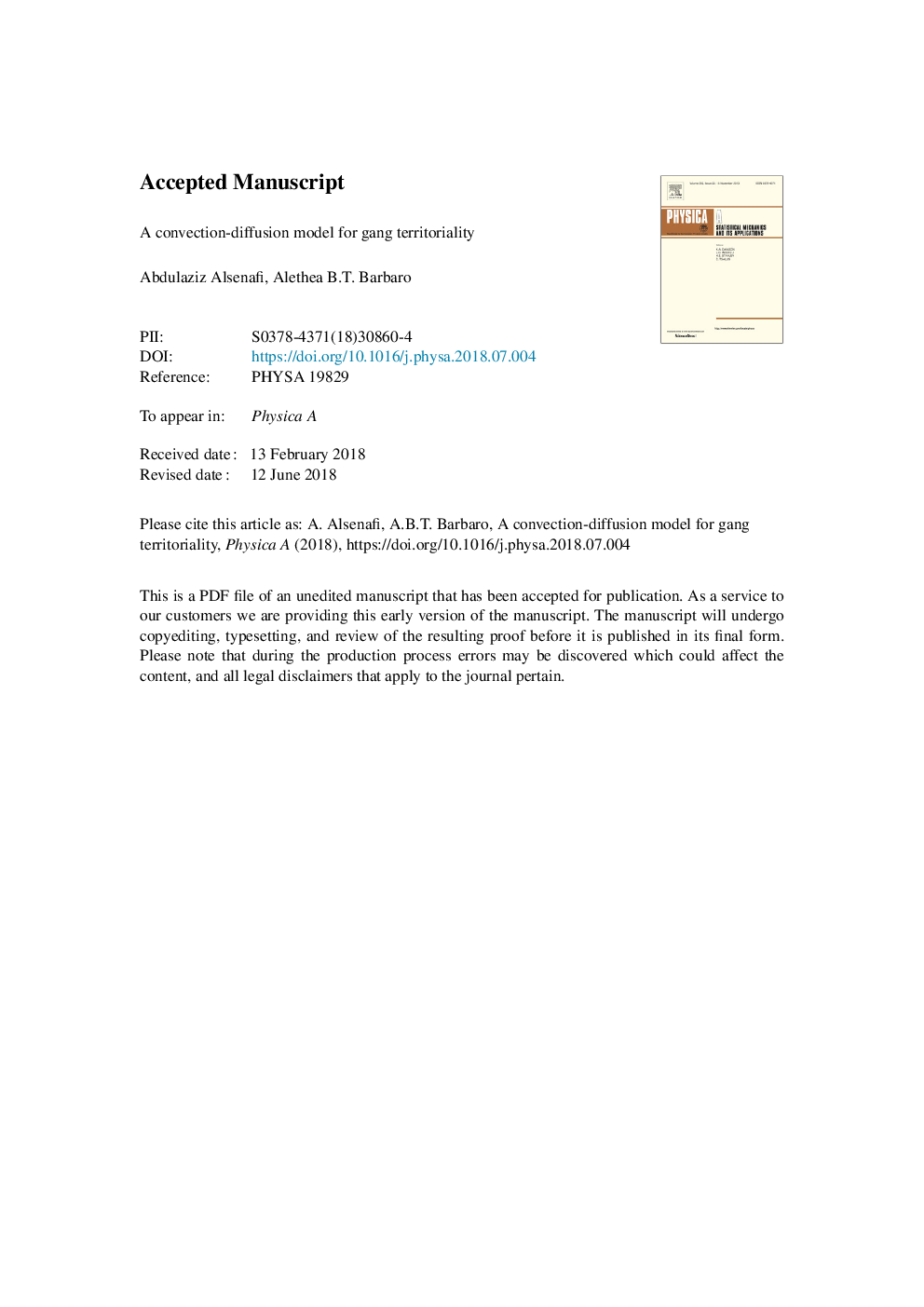| کد مقاله | کد نشریه | سال انتشار | مقاله انگلیسی | نسخه تمام متن |
|---|---|---|---|---|
| 7374791 | 1480063 | 2018 | 41 صفحه PDF | دانلود رایگان |
عنوان انگلیسی مقاله ISI
A convection-diffusion model for gang territoriality
ترجمه فارسی عنوان
یک مدل انتقال پراکندگی برای مرزبندی باند
دانلود مقاله + سفارش ترجمه
دانلود مقاله ISI انگلیسی
رایگان برای ایرانیان
کلمات کلیدی
انتقال فاز، مدل جداسازی، مدل سازی جرم تشکیل حوزه مدل مبتنی بر عامل، عبور از نفوذ،
ترجمه چکیده
ما یک مدل مبتنی بر عامل را برای شبیه سازی توسعه قلمرو باند که انگیزه گرافیتی بر روی یک شبکه گسسته دو بعدی شکل می دهد ارائه می دهیم. برای سادگی، فرض می کنیم که دو باندهای رقیب وجود دارد، و آنها برای قلمرو رقابت می کنند. در این مدل عوامل نشان دهنده اعضای گروه باند و حرکت با توجه به پیاده روی تصادفی متعصب، اضافه کردن گرافیتی با برخی از احتمال حرکت آنها و به ترتیب اجتناب از گرافیتی دیگر باند است. همه تعاملات عامل غیر مستقیم هستند، با تعاملات رخ می دهد از طریق میدان گرافیتی. ما به صورت عددی نشان می دهیم که به عنوان پارامترهای مختلف، یک انتقال فاز بین یک حالت خوب مخلوط و یک وضعیت به خوبی جداسازی می شود. نتایج عددی نشان می دهد که توده سیستم، سرعت پراکندگی و سرعت گرافیتی بر پارامتر بحرانی تأثیر می گذارد. از مدل گسسته، ما یک سیستم پیوسته معادلات انتقال حرارت را برای توسعه محصور می آوریم. با استفاده از معادلات پیوسته، ما یک تحلیل پایداری خطی را برای تعیین ثبات راه حل های تعادلی انجام می دهیم و می توانیم مکان دقیق انتقال فاز را در فضای پارامتر به عنوان تابع توده سیستم و ایجاد و نرخ رسوب گریفیتی تعیین کنیم .
موضوعات مرتبط
مهندسی و علوم پایه
ریاضیات
فیزیک ریاضی
چکیده انگلیسی
We present an agent-based model to simulate gang territorial development motivated by graffiti marking on a two-dimensional discrete lattice. For simplicity, we assume that there are two rival gangs present, and they compete for territory. In this model, agents represent gang members and move according to a biased random walk, adding graffiti with some probability as they move and preferentially avoiding the other gang's graffiti. All agent interactions are indirect, with the interactions occurring through the graffiti field. We show numerically that as parameters vary, a phase transition occurs between a well-mixed state and a well-segregated state. The numerical results show that system mass, decay rate and graffiti rate influence the critical parameter. From the discrete model, we derive a continuum system of convection-diffusion equations for territorial development. Using the continuum equations, we perform a linear stability analysis to determine the stability of the equilibrium solutions and we find that we can determine the precise location of the phase transition in parameter space as a function of the system mass and the graffiti creation and decay rates.
ناشر
Database: Elsevier - ScienceDirect (ساینس دایرکت)
Journal: Physica A: Statistical Mechanics and its Applications - Volume 510, 15 November 2018, Pages 765-786
Journal: Physica A: Statistical Mechanics and its Applications - Volume 510, 15 November 2018, Pages 765-786
نویسندگان
Abdulaziz Alsenafi, Alethea B.T. Barbaro,
